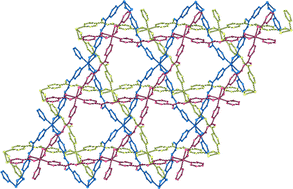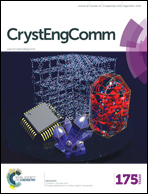Centric and acentric networks using low-symmetry heterotopic carboxylate/pyridyl ligands†
Abstract
Four isomeric, heterotopic ligands, containing both a pyridyl and a carboxylate functional group, have been incorporated into a series of 1D and 2D coordination polymers with the low symmetry of the ligands postulated to aid the formation of acentric materials. The ligands contain pyridyl and benzoate functionalities separated by a hydrazinyl core, with the substitution positions on the two aromatic groups being either meta or para (yielding a total of 4 isomers). The neutral organic molecules have been structurally characterised and form hydrogen-bonding networks through interactions between the carboxylic acid, the pyridyl nitrogen atom and the hydrazinyl NH group, including an unusual acentric structure in which Z′ = 6 in the case of the 3-pyridyl/4-benzoic acid isomer (3py4bzH). Reaction with transition metal salts forms coordination polymers with the generic solvent-free formula [ML2]n in all cases. The mixed meta/para substituted ligands (3py4bzH and 4py3bzH) both form centrosymmetric coordination polymers, 1D and 2D respectively, containing similar M2L2 ring motifs due to the comparable angle between the coordinating groups in the two ligands. 3py3bzH and 4py4bzH both form acentric 4,4 sheets that pack in a helical manner with 4-fold and 3-fold screw axes, respectively, induced by the differences in geometry within the sheets.



 Please wait while we load your content...
Please wait while we load your content...